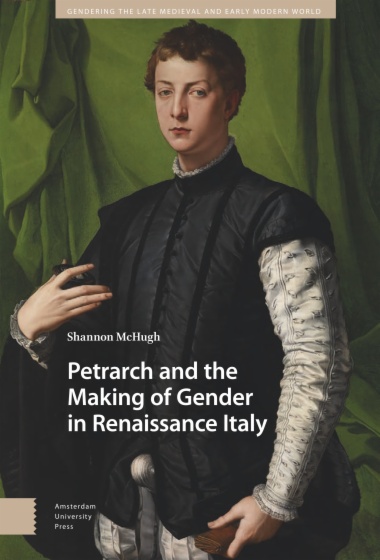This book is a new history of early modern gender, told through the lyric poetry of Renaissance Italy. In the evolution of Western gender roles, the Italian Renaissance was a watershed moment, when a confluence of cultural developments disrupted centuries of Aristotelian, binary thinking. Men and women living through this upheaval exploited Petrarchism’s capacity for subjective expression and experimentation - as well as its status as the most accessible of genres - in order to imagine new gendered possibilities in realms such as marriage, war, and religion. One of the first studies to examine writing by early modern Italian men and women together, it is also a revolutionary testament to poetry’s work in the world. These poets’ works challenge the traditional boundaries drawn around lyric’s utility. They show us how poems could be sites of resistance against the pervading social order - how they are texts capable not only of recording social history, but also of shaping it.
- Cover
- Table of Contents
- Acknowledgments
- Introduction
- Part 1. Literary and Sociohistorical Context
- 1. The People’s Petrarch: Early Modern Italian Readers
and the Gender of Celebrity
- 2. Context: Men and Women Writers in Late-Renaissance Italy
- Part 2. Making Gender Through Petrarchism
- 3. Ventriloquized Lyric
- 4. Correspondence Lyric
- 5. Religious Lyric
- 6. Conjugal Lyric
- Afterword
- Volume Bibliography
- Index
- List of Illustrations
- Figure 0.1: Vincenzo Cartari, Le imagini de i dei de gli antichi con figure nuovamente stampate. Venice: Ziletti, 1571. Illustration of “bearded Venus” (Venere con la barba), 552. RB 375693, The Huntington Library, San Marino, CA.
- Figure 0.2: Agnolo Bronzino, Cosimo de’ Medici in Armor, c. 1545. Museo Nacional Thyssen-Bornemisza, Madrid. © Museo Nacional Thyssen-Bornemisza, Madrid.
- Figure 0.3: Agnolo Bronzino, Portrait of Cosimo I de’ Medici as Orpheus, c. 1537–1539. Philadelphia Museum of Art, Philadelphia. Photo: Philadelphia Museum of Art: Gift of Mrs. John Wintersteen, 1950, 1950-86-1.
- Figures 1.1a and 1.1b: Petrarch’s Virgilian Codex, 1338. Petrarch’s autograph note on Laura, flyleaf, and Simone Martini, Allegoria virgiliana, illuminated frontispiece. A79 inf., Biblioteca Ambrosiana, Milan. © Veneranda Biblioteca Ambrosiana/Mondadori P
- Figure 1.2: Unattributed copy of Petrarch’s Note on Laura, composed in Florence in 1468, fol. 1r. General Manuscripts 109, Box 285, Folder 5127a. The Spinelli Archive, Beinecke Rare Book and Manuscript Library, Yale University, New Haven, CT.
- Figure 1.3: Manuscript copy of pseudo-da Tempo’s Life of Petrarch: detail, transcription of Petrarch’s letter to Giacomo Colonna about Laura, fifteenth century, fol. 5r. Barb. Lat. 3943, Biblioteca Apostolica Vaticana, Vatican City.
- Figures 1.4a and 1.4b: Untitled edition of Petrarch’s Canzoniere and Trionfi. Venice: Gabriele di Pietro, 1473. Transcription of Petrarch’s Note on Laura and letter to Giacomo Colonna, fols. 174r–v (of unnumbered signatures). Special Collections, folio In
- Figure 1.5: Francesco Petrarca, Le volgari opera. Venice: Giovanni Antonio da Sabbio, 1525. Map of Vaucluse in Alessandro Vellutello’s edition, fols. AA4v–AA5r. Photo: Cambridge, MA: Harvard College Library Digital Imaging Group, 2015.
- Figure 1.6: Francesco Petrarca, Il Petrarca. Venice: Gabriele Giolito, 1545. Woodcut depicting Petrarch and Laura in Lodovico Domenichi’s edition, fol. A3r. Special Collections, Case Y 712.P4054, The Newberry, Chicago.
- Figure 1.7: Francesco Petrarca, Il Petrarca: con l’espositione d’Alessandro Vellutello. Venice: Gabriele Giolito, 1558. Marginal annotation of Laura’s death date (“Morì Mad[onn]a Laura ...”), fol. 4r. 243-105q. Folger Shakespeare Library, Washington, DC.
- Figure 3.1: Gabriele Fiamma, Rime spirituali. Venice: Francesco de’ Francheschi Senese, 1570. Author’s commentary surrounding poem no. 94, 327. *IC5 F4424 570r, Houghton Library, Harvard University, Cambridge, MA.
- Figure 4.1: Pietro Bembo, Delle rime di M[esser] Pietro Bembo. Venice: Nicolini da Sabio, 1535. Sonnet from Colonna to Bembo, with indication of his reply, 48r (unnumbered page). *IC5 B4225 530rb, Houghton Library, Harvard University, Cambridge, MA.
- Figure 4.2: Tullia d’Aragona, Rime della Signora Tullia di Aragona et di diversi a lei. Venice: Gabriele Giolito, 1547. Exchange, proposta by d’Aragona and risposta by Varchi, ordered consecutively, 15r. *IC5.Ar122.547r, Houghton Library, Harvard Universi
- Figure 4.3: Benedetto Varchi, Sonetti, parte prima. Florence: Lorenzo Torrentino, 1555. First page of index of names of addressees, page unnumbered. *IC5 V4227 555s (A), Houghton Library, Harvard University, Cambridge, MA.
- Figure 4.4: Benedetto Varchi, Sonetti, parte prima. Florence: Lorenzo Torrentino, 1555. Alphabetical list of incipits followed by names of addressees, page unnumbered. *IC5 V4227 555s (A), Houghton Library, Harvard University, Cambridge, MA.
- Figure 4.5: Benedetto Varchi, Sonetti, parte seconda. Florence: Lorenzo Torrentino, 1557. Exchange, proposta by Bembo and risposta by Varchi, ordered consecutively, 172. *IC5 V4227 557s, Houghton Library, Harvard University, Cambridge, MA.
- Figure 4.6: Orsatto Giustinian and Celio Magno, Rime di Celio Magno et Orsatto Giustinian. Venice: Andrea Muschio, 1600. Title page. 378046, The Huntington Library, San Marino, CA.
- Figure 6.1: Bernardo Tasso, Rime di Messer Bernardo Tasso. Divise in cinque libri nuovamente stampate. Venice, Gabriele Giolito, 1560. “On the death of the poet’s wife” (In morte de la moglie), V.79. *IC5 T1852 560r, Houghton Library, Harvard University,
- Figure 6.2: Berardino Rota, Sonetti del S[ignor] Berardino Rota in morte della S[igno]ra Portia Capece sua moglie. Naples: Mattia Cancer, 1560. Title page. *IC5 R7402 560s, Houghton Library, Harvard University, Cambridge, MA.

